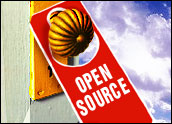
Linspire, a company that is aiming to develop a more mainstream version of Linux, has often taken heat for being less open with itssoftware than other Linux distrubution providers. Now, the San Diego-based firm is inviting criticism again, this time by offering a free version of its Linuxoperating system that includes proprietary drivers and other code intended to deliver better multimedia support. The company launched Freespire 1.0 last week.
Linspire has acquired proprietary drivers, codecs and applications — including MP3, Windows Media, Real, QuickTime, Java Flash, ATI, Nvidia, WiFi 802.11 wireless and modem support — “little by little,” Linspire CEO Kevin Carmony told LinuxInsider. The company secured some of the technology rights at significant expense, got some for free, and obtained the rest at every price point in between.
Responding to critics who support free and open source software (FOSS) exclusively, Carmony said he thinks a better way to support open source is to force it to compete with proprietary solutions — giving users the option to choose Linux and still be able to browse the Internet or watch DVDs without too much tinkering.
“We’ve got to get more people asking for [Linux],” he said. “Those proprietary codecs allow people to ask for it. If you take all that choice away from them, it goes all the way back to geekdom.”
Free or Fee
Linspire announced its intention to create a Debian-based Linux OS last April. Freespire 1.0 is now available for download via Linspire’s Web site. For the most part, Linspire was able to pack the operating system with proprietary code aimed at boosting out-of-the-box Linux performance, Carmony said. The exception was DVD playback software. Users who wish to access this function must pay US$10 for it via Linspire’s Click and Run (CNR) service. The company makes most of its revenue from the CNR service.
Linspire is also making a pure FOSS version of Freespire available without the proprietary software included, called “Freespire 1.0 OSS Edition.”
Carmony is not worried about Freespire’s availability hurting revenue for the Linspire 5.0 commercial version, available for about $50.
Greater Freedom
Some staunch Linux supporters have been critical of Linspire, formerly known as Lindows, because it uses Linux to sell a commercial OS that mimics Windows and does not offer the root-level access, controls and flexibility of other Linux distros.
FOSS fans are often known to boycott proprietary products or to lobby for a Linux or open source version of them, according to Carmony. He believes, however, that by allowing Linux users to use third-party software that is sometimes ahead of open source alternatives, the number of Linux users will grow, and its commercial viability will improve.
“If we want a bigger army, Linux needs to be used by moms and dads and kids and secretaries,” he said. “Let’s get a lot more people in this army.”
Greater use will result in better products, Carmony contended.
Uphill Battle
Developers of consumer Linux distros such as Linspire andXandros are doing more to appeal to mainstream home PC consumers and compete with Mac OS X and Windows, but there is still a long way for Linux to go before it becomes a popular desktop choice, Endpoint Technologies Associates Founder and President Roger Kay told LinuxInsider.
“I just think that it’s pretty much an uphill battle to get major companies to devote resources [to Linux],” he said.
Linux is becoming “more civilized,” and “more laudable,” thanks to efforts by Linspire and Xandros, Kay allowed.
However, he added, the biggest hurdle for Linux to overcome is users’ desire for Windows, which many believe is the most compatible operating system available.


















































